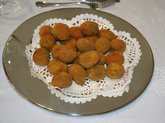Description
Ascolana Olives: A Journey into the Taste of the Marche Region
The name of the dish is a tribute to the city of Ascoli Piceno, its cradle. Ascolana Olives are typical of the area, but their fame has crossed national borders, becoming a symbol of Marche culinary excellence.
Today, Ascolana Olives are an unmissable dish during local holidays and celebrations, and can be purchased in egg pasta shops and delicatessens in the area. In 2005, Ascoli olives from Piceno obtained DOP (Protected Designation of Origin) recognition, guaranteeing the quality and authenticity of the product. A consortium established in 2018 protects the production of this gastronomic treasure.
For the rich filling, three types of meat are combined: beef, pork and chicken (or turkey), previously cooked and then mixed with parmesan grated cheese, eggs, breadcrumbs, vegetables and flavourings. The olives are skillfully pitted, cut into spirals, and filled with the tasty filling. Subsequently, they are dipped in flour, then in egg and breadcrumbs, to finally be immersed in boiling oil. In more recent times, alongside the traditional recipe, a seafood variant has emerged, where the meat filling is replaced by different varieties of fish typical of the Adriatic Sea, called "Fish Olives". This evolution has contributed to spreading the Ascolana Olives well beyond the borders of the Marche.
It is a tradition to serve the Ascolana Olives together with the "Cremini", a sweet cream breaded and fried which harmonizes perfectly with the bitter flavor some fried olives. This delicious dish is part of the classic "Fritto Misto all'Ascolana", which also includes lamb cutlets, artichokes and courgettes, all strictly fried.
Their history dates back to the 19th century, when cooks at service of the noble families of Ascoli invented the olive filling to exploit the variety and quantity of meat available, thanks to the gifts of the farmers.
These olives, already known in Roman times as "colymbades", have been described by illustrious characters such as Cato the Censor, Varro, Martial and Petronius Arbiter.
The Olivetan monks in the Piceno area were the precursors of the organization of olive tanning, testifying to the deep-rooted local tradition linked to the preparation of table olives.
Over time, artists of the caliber of Gioachino Rossini and Giacomo Puccini, as well as General Giuseppe Garibaldi, have praised and appreciated the Olives all'Ascolana.
